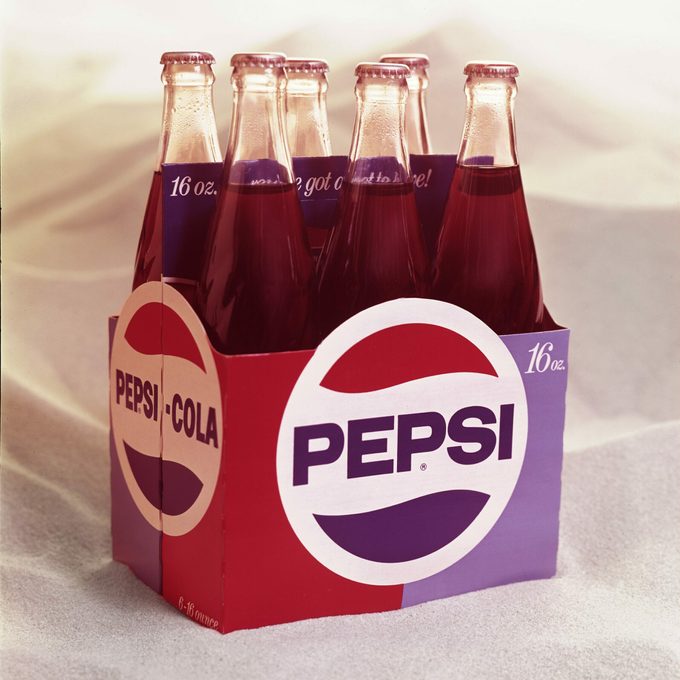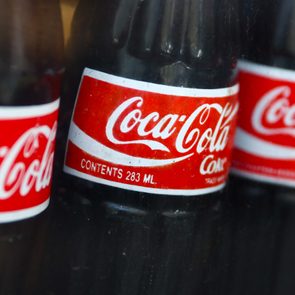If you're a Pepsi person, you'll want to know how the soda got its name. The 127-year-old brand has a history you may not have expected.

Here’s How Pepsi Really Got Its Name

When you hear the name Pepsi, your mind may jump to one of its iconic ad campaigns, catchy slogans or the many famous faces who have endorsed the brand over the years. (Anyone else still have Britney Spears’s “Ba, pa-pa-pa, ba, pa-pa-pa … the joy of Pepsi” pop into your head when you see that red, blue and white Pepsi bottle? Just me?)
You might assume the soft drink’s name is a reference to the “pep” you get in your step after taking a sip of the caffeinated, sugary concoction. But the origin story behind Pepsi’s name is a bit more unexpected than that.
Read on to learn the history behind the nearly 127-year-old brand, including how it got its name. (Hint: Pepsi was not what it was originally called!)
Get Reader’s Digest’s Read Up newsletter for more food news, humor, travel, tech and fun facts all week long.
So what was Pepsi originally called?
The original formula was first called Brad’s Drink—catchy, huh? Not quite, but it was named for Caleb “Doc” Bradham, the beverage’s founder and a local pharmacist in the town of New Bern, North Carolina.
“When Pepsi entered the market in 1898, initially branded as Brad’s Drink, it faced the challenge of competing against Coca-Cola’s established presence,” Donna Wertalik, professor of practice and director of student excellence in the marketing department at Virginia Tech, tells Reader’s Digest.
Once the brand started gaining popularity, Bradham threw everything he had into making the drink successful and helping it stand out from its competition, beginning with applying for a trademark and forming the Pepsi-Cola company in 1902. Then, in 1903, to increase production and availability, Bradham moved bottling from his drugstore to a rented warehouse and sold 7,968 gallons of syrup in the first year of production, according to Pepsi’s website.
How did Pepsi get its name?

Within the first year of its creation, the beverage went through a major name change, from Brad’s Drink to Pepsi-Cola. According to the Pepsi website, Bradham “bought the name ‘Pep Kola’ from a local competitor. In 1903, one of Pepsi’s first slogans was: “Exhilarating, Invigorating, Aids Digestion.” (There’s more on Pepsi’s claim to digestive benefits in the next section.)
“The strategic rebranding to Pepsi-Cola was a calculated move to position the drink within the medicinal beverage market, directly challenging Coca-Cola’s offerings,” Wertalik says. Remember that Coca-Cola was initially described in 1886 by its creator, John Styth Pemberton, an Atlanta-based pharmacist, as a “brain tonic and intellectual beverage.”
“This rebranding was not merely a name change but a deliberate effort to align Pepsi with the digestive benefits implied by its name, foreshadowing the intense rivalry known as the Cola Wars,” Wertalik explains.
How is the name Pepsi related to indigestion?
Well, the word dyspepsia literally means “indigestion,” and Bradham positioned Pepsi as an “aid” to soothe the stomach, as that original slogan stated. Another digestion-related term tied to Pepsi is pepsin, a digestive enzyme that aids in breaking down proteins.
Despite the fact that pepsin was never an ingredient of Pepsi-Cola, “Bradham believed that his new drink aided digestion similar to the way the pepsin enzyme does,” according to the Encyclopedia of Pepsi-Cola Collectibles. Indeed, a 1907 ad for Pepsi-Cola clearly states that the beverage “aids digestion.” (This was well before the federal government regulated food advertisements.)
Was Pepsi a health drink?
Though Pepsi was originally marketed as a digestive aid soon after it launched, it was never proven to be one. Keep in mind that it was directly competing against Coca-Cola, which was presenting itself as a health tonic. So making a loose health connection made sense at the time.
“To understand the competitive landscape between Pepsi and Coca-Cola, it’s important to note that Coca-Cola launched in 1886, 12 years before Pepsi,” Wertalik says. “Coca-Cola was marketed as a remedy for headaches, exhaustion and various nervous afflictions, leveraging the supposed medicinal benefits of coca-leaf extract and kola nuts.”
While virtually no one would consider Pepsi to be “healthy” today, its place with loyal soda lovers and its stance as a market disruptor remain strong. “Pepsi’s positioning and slogans have consistently offered consumers a fresh alternative in the cola category,” says Wertalik. “From the start, Pepsi introduced energy and vitality into its brand and marketing tactics, as evidenced in its campaigns like ‘Pepsi Generation,’ ‘Pepsi Refresh’ and the current ‘Thirsty for More.’ These campaigns emphasize a forward-thinking, youthful perspective, often featuring celebrities and influencers who embody the brand’s dynamic spirit.” Talk about pep, indeed!
RELATED:
- The Hidden Message You Never Noticed on a Coca-Cola Bottle
- Here’s Why the Coca-Cola Logo Is Red
- This Is Why So Many Logos Are Red
About the expert
|
Why trust us
At Reader’s Digest, we’re committed to producing high-quality content by writers with expertise and experience in their field in consultation with relevant, qualified experts. We rely on reputable primary sources, including government and professional organizations and academic institutions as well as our writers’ personal experiences where appropriate. We verify all facts and data, back them with credible sourcing and revisit them over time to ensure they remain accurate and up to date. Read more about our team, our contributors and our editorial policies.
Sources:
- Pepsi Store: “Pepsi’s history”
- Pepsico.com: “When was Pepsi-Cola invented? How did it get its name?”
- New York Times: “How Coca-Cola Obtains Its Coca”
- Encyclopedia of Pepsi-Cola Collectibles
- Donna Wertalik, professor of practice and director of student excellence in the marketing department at Virginia Tech; email interview, April 26, 2025



